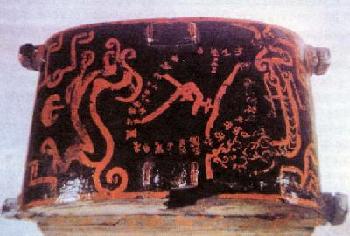Chinese ancestors began to make lacquerware about 7,000 years ago. In 1978, red lacquer bowls and tubes of the Hemudu Culture were found in Yuyao, Zhejiang Province. According to scientific analysis, the coatings are natural lacquers.
 |
| Cloud pattern lacquerware |
After the Han Dynasty, the variety of lacquerware increased, and the craft flourished for five centuries starting in the Warring States Period (475-221BC). The scale of lacquerware production had already become very large in the Warring States Period. Lacquerware was one of the main economic resources of the time, and there were specific officials in charge of its production. According to historical records, the ancient Chinese sage of Zhuangzi used to be an officer in charge of lacquerware production. The production process was very complicated, necessitating a strong work force and long working hours. Lacquerware was very expensive. It came in many varied forms and was widely used for furniture, utensils, stationary, art works, musical instruments, funeral goods and weapons. The nobles moved their attention from bronzeware to lacquerware because the latter was bright, light, easy to clean, had heat insulation and corrosion resistant qualities and could be inlaid and painted with many colors.
Lacquerware was, however, usually coated black and decorated with red designs or coated red and decorated with black designs. About 220 lacquerware objects were unearthed in Zeng Houyi's Tomb in Hubei Province. They are the earliest and most superb lacquerware of the Chu Kingdom of the Warring States Period. Lacquerware items, including clothing storage boxes, which were unearthed in the tomb, are richly varied, of large size and simple style; they reflect the charm of the culture of the Chu Kingdom. The designs on some of the boxes make them very valuable. In the center of one is aZhuancalligraphy character, meaning a star, surrounded by the names, also inZhuancharacters, of the phases of the moon in a circle. On the two ends are designs of a blue dragon and a white tiger. This box is a rare relic of great value for research into ancient Chinese astronomy as it is the earliest written record of moon phases yet found in China.
Some lacquerware was painted with fairy tales. For example, the ancient Chinese tale ofHou Yi Shooting the Sunwas painted on a black coated and red design clothing box. Mushroom-shaped and colored clouds and two twisting double headed snakes with human faces form the background. On the two sides are two trees, the tall one with 11 branches and the short one with nine. On the tip of each branch is a circle radiating brilliant light, symbolizing the sun. Between the two trees, a man shoots an arrow at a bird on the tall tree. The story demonstrates mankind's successful battle against nature.
 |
| Lacquerware painting on a clothing box |
Han Dynasty (206BC-220AD) lacquerware mainly used black and red colors. In the painted design of one piece, there are 90 immortals, and birds and beasts with different postures and expressions. The immortals are dancing with their long sleeves waving in the air, sitting quietly with their chins in their hands, or shooting arrows with concentrated expressions. The animals being hunted are turning their heads in panic and running swiftly away. Beautiful patterns of dragons, phoenixes, leaves, grass, cloud and various other things were drawn on the lacquerware objects to add to their elegance. Lacquerware reached its heyday in the Han Dynasty and more lacquerware products emerged. These included boxes, plates, earrings, bowls, baskets, trunks, rulers, kettles, chessboards and stools. Meanwhile, many new crafting techniques and decorative methods were also developed.
The patterns on the lacquerware are simple lines or complicated pictures, depending on the items' different functions. The contrast between the black and red colors creates a special artistic effect. The black and red pictures on the lacquerware present a mysterious and ever-changing fairy world inhabited by human beings and immortals.
